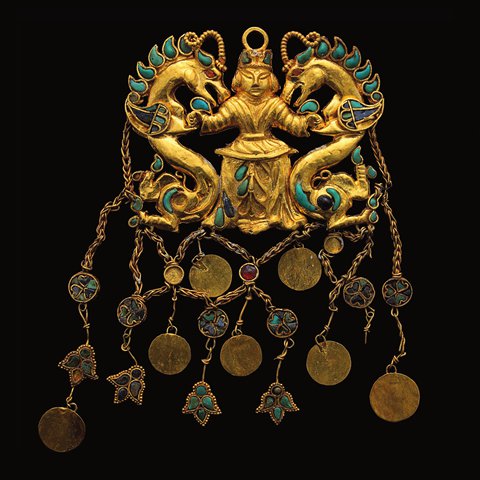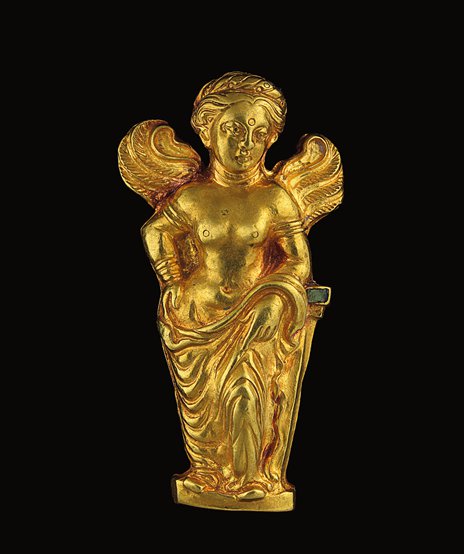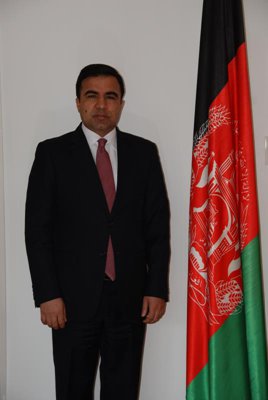
An Afghan ornament featuring a ruler accompanied by dragons on display at the Palace Museum Photo: Courtesy of Ambassador Janan Mosazai

An Afghan statue of Aphrodite on display at the Palace Museum Photo: Courtesy of Ambassador Janan Mosazai

Afghan Ambassador to China Janan Mosazai Photo: Courtesy of Ambassador Janan Mosazai
"As long as the culture lives, the nation lives," said Shan Jixiang, head of China's Palace Museum, at the opening ceremony to the exhibition
Afghanistan - Treasures from the National Museum, Kabul.
Afghanistan is a country with a long history and a rich cultural heritage. However, due to decades of war and turbulence, numerous cultural relics have been destroyed or stolen.
Fortunately, there are those working hard to protect Afghan relics and ensure their continued survival.
The ongoing exhibition, which opened on March 17 and runs until June 17 at the Palace Museum in Beijing, boasts 231 exhibits of ancient Afghan artifacts.
In an exclusive interview on April 6, Janan Mosazai, ambassador of Afghanistan to China, told the Global Times that when it comes to the tracking and reclamation of cultural relics overseas, the Afghan government "has made a lot progress," but still "needs continuous support and assistance from international organizations and other countries."
Cultural crossroads
The unique geographical location of Afghanistan made it the perfect crossroads for cultures from all directions of the compass. As a result, the lives of the people of Afghanistan, as well as the items they used day by day, were influenced by numerous civilizations.
For example, a golden statue of Aphrodite stands among the exhibits. While the goddess is originated from Greek mythology, she looks more like an Indian woman, complete with a bindi in the middle of her forehead.
Another relic features two dragons that look very much like the type seen in China, yet these also come with the wings, a very local addition.
"The Afghan treasures and exhibitions at the Palace Museum are a small but beautiful example of the different cultural influences that have come to Afghanistan and that have actually gone out of Afghanistan into neighboring countries and other countries," Mosazai told the Global Times.
The 200 plus exhibits were originally part of the Bactrian Hoard, regarded as one of the greatest archaeological discoveries in the world.
However, after the discovery of the Bactrian Hoard in 1978, wars and disputes swept over the land of Afghanistan for more than two decades, leading to many relics either being destroyed or smuggled overseas.
When the Taliban militant group seized Kabul, capital of Afghanistan, in 1996, the Bactrian Hoard became a major target. However, due to the efforts of the staff at the Afghan National Museum, many of whom gave their lives, the Bactrian Hoard went unmolested.
According to a report from sohu.com, to protect these relics, many Afghan people were tortured, castrated and even beheaded.
Heritage of all humanityCalling the world to come together in the support of cultural protection, Mosazai explained that "the historic artifacts and the archeological heritage that we have in Afghanistan belongs not only to the people of Afghanistan, it belongs to the whole region and to all of humanity. Ancient artifacts everywhere in the world belong to the entire human family."
Tracking down and reclaiming the country's lost heritage has been a major part of Afghan government efforts over the past 15 to 16 years. Working in cooperation with international organizations like UNESCO, as well as other countries and private individuals, Afghanistan is now able to better document, identify, protect and preserve its relics that have been scattered all over the globe.
"Just three months ago, we were very grateful to receive 300 ancient relics that were collected, protected and preserved by a Japanese citizen, who brought them back to Kabul. They are now back at the National Museum where they belong," Mosazai noted.
"We believe that cultural artifacts - discovered in Afghanistan and excavated in Afghanistan - belong to Afghanistan. And they look at their most beautiful at the National Museum of Afghanistan and other museums in Afghanistan," he later added.
Another important task at the moment is the renovation of the National Museum of Afghanistan, which was severely damaged during the 1990s.
Mosazai also explained that they are seeking to expand the museum grounds, "We have too many artifacts that we cannot display at the national museum, we don't have enough space."
Upgrading the museum is only a part of efforts to improve cultural protections, the ambassador added that "we also require a lot of support in the area of building human capacity… the training of experts is an important element in the field of preservation and protection."
To this end the Afghan government is in discussions with related departments in China.
"We hope that we will be able to achieve specific results and progress in these areas in the months to come," the ambassador said.
While the exhibition at the Palace Museum lasts only three months, Mosazai told the Global Times that they are also thinking about taking the exhibition to other cities in China as part of Afghanistan's efforts to increase cultural communication with China.
"And we will also be working very closely with our Chinese partners to develop a framework for closer and deeper cultural cooperation in different areas, such as the signing of agreements, exchanging delegations and cooperating in the training of experts," he added.






